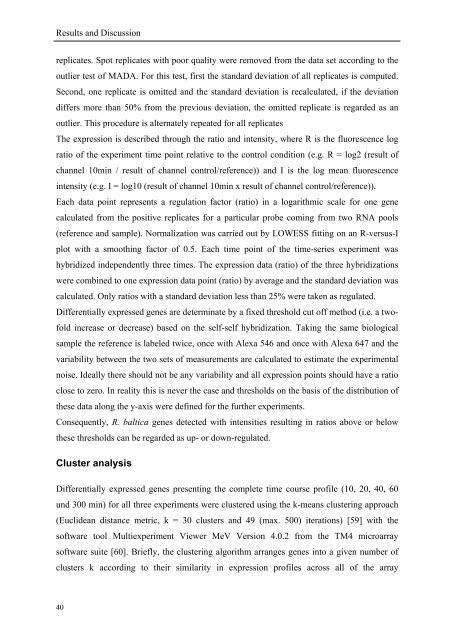a Whole Genome Array Approach - Jacobs University
a Whole Genome Array Approach - Jacobs University
a Whole Genome Array Approach - Jacobs University
You also want an ePaper? Increase the reach of your titles
YUMPU automatically turns print PDFs into web optimized ePapers that Google loves.
Results and Discussion<br />
replicates. Spot replicates with poor quality were removed from the data set according to the<br />
outlier test of MADA. For this test, first the standard deviation of all replicates is computed.<br />
Second, one replicate is omitted and the standard deviation is recalculated, if the deviation<br />
differs more than 50% from the previous deviation, the omitted replicate is regarded as an<br />
outlier. This procedure is alternately repeated for all replicates<br />
The expression is described through the ratio and intensity, where R is the fluorescence log<br />
ratio of the experiment time point relative to the control condition (e.g. R = log2 (result of<br />
channel 10min / result of channel control/reference)) and I is the log mean fluorescence<br />
intensity (e.g. I = log10 (result of channel 10min x result of channel control/reference)).<br />
Each data point represents a regulation factor (ratio) in a logarithmic scale for one gene<br />
calculated from the positive replicates for a particular probe coming from two RNA pools<br />
(reference and sample). Normalization was carried out by LOWESS fitting on an R-versus-I<br />
plot with a smoothing factor of 0.5. Each time point of the time-series experiment was<br />
hybridized independently three times. The expression data (ratio) of the three hybridizations<br />
were combined to one expression data point (ratio) by average and the standard deviation was<br />
calculated. Only ratios with a standard deviation less than 25% were taken as regulated.<br />
Differentially expressed genes are determinate by a fixed threshold cut off method (i.e. a twofold<br />
increase or decrease) based on the self-self hybridization. Taking the same biological<br />
sample the reference is labeled twice, once with Alexa 546 and once with Alexa 647 and the<br />
variability between the two sets of measurements are calculated to estimate the experimental<br />
noise. Ideally there should not be any variability and all expression points should have a ratio<br />
close to zero. In reality this is never the case and thresholds on the basis of the distribution of<br />
these data along the y-axis were defined for the further experiments.<br />
Consequently, R. baltica genes detected with intensities resulting in ratios above or below<br />
these thresholds can be regarded as up- or down-regulated.<br />
Cluster analysis<br />
Differentially expressed genes presenting the complete time course profile (10, 20, 40, 60<br />
und 300 min) for all three experiments were clustered using the k-means clustering approach<br />
(Euclidean distance metric, k = 30 clusters and 49 (max. 500) iterations) [59] with the<br />
software tool Multiexperiment Viewer MeV Version 4.0.2 from the TM4 microarray<br />
software suite [60]. Briefly, the clustering algorithm arranges genes into a given number of<br />
clusters k according to their similarity in expression profiles across all of the array<br />
40

















